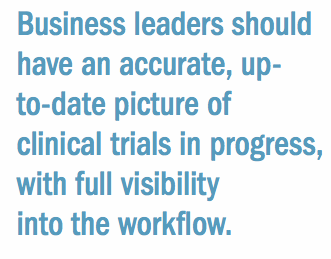It’s Time to Transform Clinical Trial Operations
Applied Clinical Trials
The need to move beyond a point-solutions approach to one built around applications designed to manage the end-to-end clinical trial process is crucial.
Managing clinical trials is an arduous process. There are many moving parts across a growing, complex ecosystem of internal and external stakeholders. Technology has alleviated some of the pain, but it has also created unintended consequences for operations teams and business leaders. Point solutions for study startup, electronic trial master files (eTMFs), and clinical trials management have improved certain areas, but the clinical operations environment remains highly fragmented.
It’s time to move beyond a point-solution approach if a seamless, end-to-end clinical operations environment is ever going to be a reality. The challenge is that operations teams support different areas of the trial process, and naturally have their own processes and requirements. So it makes sense that each group implements discrete solutions to address their specific needs but they also need to access a lot of the same data, documents, and information. Yet each of their disparate systems is its own island, making it difficult for groups to share content and data across workflows and business processes.
The simple practice of conveying the study or site information can become difficult as study IDs, site IDs, investigator names, and more are all entered into one system and then duplicated in other clinical operations systems. This creates the potential for misinformation and transcribing errors, plus forces complex integration codes that must be

maintained. And then there are the crucial milestones that must be documented but require information stored across multiple places. These milestones may be related to study startup package completion and draw from the clinical trial management system (CTMS) and eTMF. Since each group has its own system, trying to access the same information is cumbersome. Teams often waste hours trying to get their hands on the right information amidst a sea of documentation.
The clinical trials process is just as painful for business leaders seeking a complete, up-to-date picture of the status of a trial or portfolio of studies. No singular view exists because content and data live in different systems. Information has to be manually pieced together in spreadsheets, creating a picture that is incomplete. This makes it difficult for country leaders to make comparisons across local studies to streamline processes for study startup, ensure compliance with their portion of the TMF, or re-use documents in subsequent trials.
Point solutions such as eTMF and study startup software have enhanced visibility, collection, tracking, and management of content and data. They have provided measurable improvements to many aspects of the trials process, but the pieces are still not connected together to create a truly end-to-end operations environment. According to a new study by CenterWatch, in fact, sites worldwide are being inundated with a growing number of technology solutions that are difficult to use and are not compatible. On average, the typical site is working with 12 different systems to collect clinical research data.
Something different is needed-an underlying technology platform and set of applications that are natively built and designed to manage the full clinical trial process. What’s needed now is a platform that would further streamline studies and give operations groups and business leaders everything they need at their fingertips to eliminate the manual handoffs and data collection. The task of sharing study IDs or other basics should be easy. But it’s not. Business leaders should have an accurate, up-to-date picture of clinical trials in progress, with full visibility into how their staff is managing the workflow, data, and business processes. And they don’t … at least, not yet.

Jennifer Goldsmith is Senior Vice President, Veeva Vault, Veeva Systems
